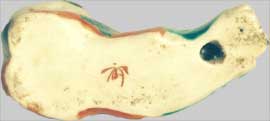 Mark under an Imari whistle
Mark under an Imari whistle
 Mark under an Imari whistle
Mark under an Imari whistle
 |
: October 2003 |
||||||||
| Discovery: A collector bought this whistle from an antique dealer. Its origin was unknown General description: It is a crawling baby shaped whistle. The child's legs are the whistle. The open mouth makes it possible to modulate the sound.
A blue mark underlines the base of the head and another one is located right before the window of the whistle.A blue spot at the top of the head and another one on the left represent the hair. The eyes are simply marked with a black point.
|
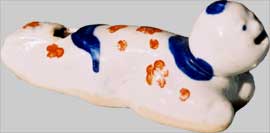   L: 7,8 cm H: 3,2 cm L: 2,9 cm |
||||||||
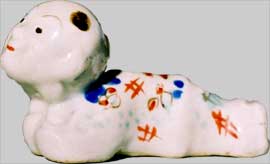   L: 7,5 cm H: 3,4 cm L: 2,9 cm |
Decorations and models:
A rarer model represents a young child holding a dog. The mouth piece is under the base.
| 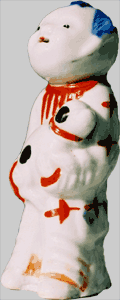 L: 3,2 cm H: 8,5 cm L: 3,3 cm |
|||||||
| Study of the object : Typology: This whistle is a globular whistle. The volume of air is small so the whistle is high-pitched. The finger hole makes it possible to modulate slightly the sound (semitone).
Technique: These moulded whistles are made with a porcelain containing kaolin added with natural clays and flux. The whistle is covered with a transparent glaze containing feldspar and quartz which is vitrified between 1200 and 1300° and forms a unit with the shard. The major blue marks (blue of cobalt) are posed before the first firing under the glaze while the decoration of the small red and gold flowers is painted over the glaze and is the subject of a second firing at a lower temperature ("muffle fire"). |
|||||||||
| Analyze: |
|||||||||
| Several specialists attribute these whistles to the Japanese production of "Imari" style made in the 19th century. Some whistles are marked but those marks are not referenced. For some authors, those whistles are "chopsticks rests" produced for the Western tables.
The Japanese porcelain was born in the 16th C. with the discovery of a kaolin deposit in the south of the archipelago on the island of Kyushu. This exportation, after an eclipse during the 18th century, started again in the 19th century.
The whistles are far from the traditional Japanese models. They are closer to the whistles in China where these baby shaped whistles are frequent. This similarity between the Imari and Chinese production is a constant due to the permanent links between these two countries.
| 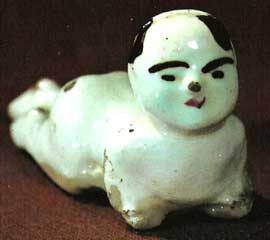 Whistle of the province of Shandong Porcelain. China Photo: "Volkstümliches chinesisches Spielzeug"' 1990. Author: Mr. LU PU. |
||||||||
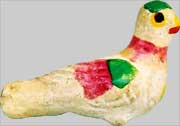 Whistle of Aomori Japan 20th century. Private col. |
The famoust traditional Japanese whistles are made in the town of Aomori. The lord who reigned in this district during the Middle Ages built a kiln for the tiles of his castle. After the firing, he let his population use the kiln for their pottery and clay toys. The famoust toy is the pigeon shaped whistle: "hato-bue". In the former times, the mothers of this region offered these whistles to their children in order to protect them from the hystery.
| 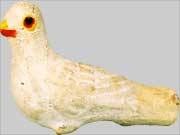 |
|||||||